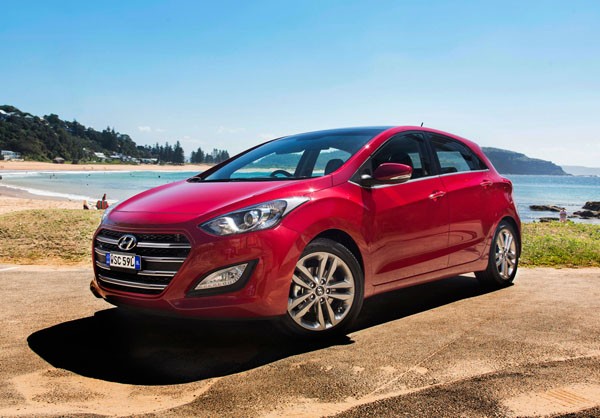The Hyundai i30, already a firm favourite with new-car buyers – it was Australia’s fourth best-selling vehicle for 2014 – has been given the once-over, making the hatchback even more appealing.
The back-to-back winner of the coveted Australia’s Best Cars Best Small Car Under $35,000 Award for the past two years, has had the automotive broom put through it for the Series II models – Active, new ActiveX, SR (replacing Elite), SR Premium and Premium.
Taking cues from its upmarket, Fluidic Sculpture 2.0-designed Sonata and Genesis big brothers, the i30 Series II boasts a deeper, more assertive front grille, while in-cabin updates include the addition in the entry-level Active of a new 5-inch touchscreen audio system with benchmark connectivity, including Pandora internet radio, Bluetooth, USB, auxiliary input, iPod and MP3.
SR Premium and Premium variants now boast ventilated front seats among a long list of standard equipment, which includes a rear-view camera combined with four-sensor rear-parking assist as standard equipment across the Series II range.
Power is offered through the choice of three engines – two petrol, one diesel – and three transmissions. A seven-speed Dual-Clutch Transmission makes its debut as an option on diesel-powered Active and ActiveX variants and standard on the diesel-only i30 Series II Premium. The gearbox will be rolled out in future Hyundai product.
However, it is in the running gear that Australia holds a special spot for the i30 Series II because it benefits from extensive suspension and steering development work carried out by Hyundai Motor Company Australia’s respected local tuning team.
SR models feature a bespoke sports suspension tune delivering sharp, responsive turn-in and improved handling while retaining the i30’s supple, rounded ride quality, which was tested to its full extent on a media launch drive on some rough ‘n’ tumble roads in the Hunter Valley.
All scribblers were in safe hands thanks to the Series II retaining the Hyundai i30’s 5-star ANCAP safety rating.
The all-new i30 variant, the ActiveX, is designed to deliver better value and additional premium features over the Active grade on which it is based. Like the Active, the new ‘X’ is available either with Hyundai’s Nu 1.8-litre MPI petrol engine, with six-speed manual or six-speed automatic transmission, or U-II 1.6-litre turbo-diesel with either six-speed manual transmission or seven-speed DCT.
The oil burner DCT on test, with seamless gearing, produced responsive handling and smooth ride, the only downside being noticeable diesel engine rattle at idle that was overcome by tyre noise on the ragged road surfaces.
The new kid on the block includes sporty, new-design 16-inch alloy wheels with machined-face finish and recessed gunmetal-grey inserts, electric folding external mirrors with inbuilt LED side repeaters, black leather trim with premium steering wheel, gear knob, door trims and instrument panel hood.
Hyundai i30 Series II comes in for some serious cosmetic work with Active and ActiveX models sporting a new larger hexagonal front grille incorporating black horizontal slats with satin chrome inserts. SR, SR Premium and Premium variants feature gunmetal grey slats with satin chrome inserts.
This trio also now come standard with LED daytime running lights and LED combination tail-lights, in addition SR variants featuring a matte-black lower diffuser incorporated into the rear bumper. SR Premium and Premium versions also feature a distinctive chrome belt-line moulding.
Active variants roll on 16-inch steel wheels with a more upmarket-looking wheel cover design. SR, SR Premium and Premium variants come standard with new-design gunmetal-grey 17-inch alloys.
Of the two petrol engines, the 1.8-litre MPi puts out 107 kW at 6500 rpm and 175 Nm at 4700 rpm, while the 2.0-litre GDi 124 kW at 6500 rpm and 201 Nm at 4700 rpm, both mated with either a six-speed manual or automatic transmission. Fuel consumption on the combined urban / highway cycle, hovers around 7 litres per 100 kilometres, according to the maker. All have Euro 5 emission rating.
The 1.6-litre CRDi diesel delivers 100 kW at 4000 rpm and 260 Nm at 1500 to 3500 rpm with six-speed manual and 300 Nm between 1750 and 2500 rpm with the seven-speed dual-clutch gearbox. Claimed fuel consumption is an impressive 4.6 and 4.9 litres per 100 kilometres respectively.
Prices start at $20,990 for the i30 1.8 MPi petrol Active six-speed manual, the new ActiveX manual is $22,090, while the range is topped off with the 1.6 CRDi Premium seven-speed double clutch transmission at $34,490. Hyundai is offering drive-away prices on selected models for the month of April.
AT A GLANCE
MODEL LINE-UP
Hyundai i30 1.8 MPi Active: $20,990 (manual), $23,290 (automatic)
Hyundai i30 1.8 MPi ActiveX: $22,090 (manual), $24,390 (automatic)
Hyundai i30 2.0 GDi SR: $25,590 (manual), $27,890 (automatic)
Hyundai i30 2.0 GDi SR Premium: $30,590 (manual), $32,890 (automatic)
Hyundai i30 1.6 CRDi Active: $23,590 (manual), $25,890 (DCT)
Hyundai i30 1.6 CRDi ActiveX: $24,690 (manual), $26,990 (DCT)
Hyundai i30 1.6 CRDi Premium: $34,490 (DCT)
Note: These prices do not include dealer or government charges. Contact your local Hyundai dealer for drive-away prices. Hyundai is offering drive-away prices on selected models for the month of April.
